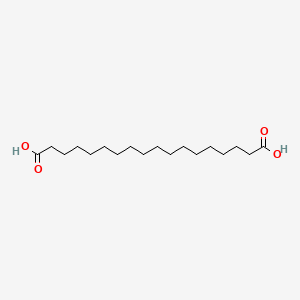

1. Octadecane-1,18-dioic Acid
1. 871-70-5
2. 1,18-octadecanedioic Acid
3. 1,16-hexadecanedicarboxylic Acid
4. Octadecane-1,18-dioic Acid
5. Rsz6pq0qqj
6. Hexadecanedicarboxylic Acid
7. 1,18-octadecadioic Acid
8. Octadecanedioate
9. Mfcd00142369
10. 1,18-octadecanedioate
11. 1,16-hexadecanedicarboxylate
12. Unii-rsz6pq0qqj
13. Odda
14. 18-octadecanedioic Acid
15. Octadecanedioicacid
16. Schembl35775
17. Amy042
18. Dtxsid1074331
19. Chebi:133086
20. 1,16-hexadecane Dicarboxylic Acid
21. Bcp32531
22. Zinc5178630
23. Lmfa01170029
24. Akos015839857
25. Cs-w005178
26. Gs-3421
27. Hy-w005178
28. Ac-32514
29. Sy025879
30. Ft-0700803
31. O0222
32. 871o705
33. A842023
34. 1,18-octadecadioic Acid;octadecane-1,18-dioic Acid
35. Q27288272
| Molecular Weight | 314.5 g/mol |
|---|---|
| Molecular Formula | C18H34O4 |
| XLogP3 | 6.4 |
| Hydrogen Bond Donor Count | 2 |
| Hydrogen Bond Acceptor Count | 4 |
| Rotatable Bond Count | 17 |
| Exact Mass | 314.24570956 g/mol |
| Monoisotopic Mass | 314.24570956 g/mol |
| Topological Polar Surface Area | 74.6 Ų |
| Heavy Atom Count | 22 |
| Formal Charge | 0 |
| Complexity | 248 |
| Isotope Atom Count | 0 |
| Defined Atom Stereocenter Count | 0 |
| Undefined Atom Stereocenter Count | 0 |
| Defined Bond Stereocenter Count | 0 |
| Undefined Bond Stereocenter Count | 0 |
| Covalently Bonded Unit Count | 1 |
